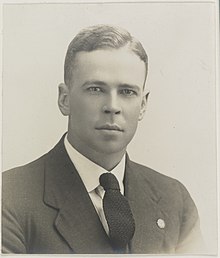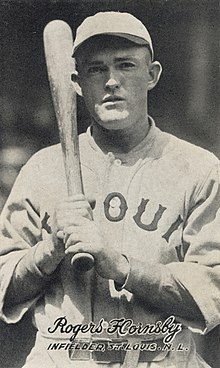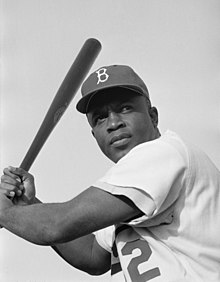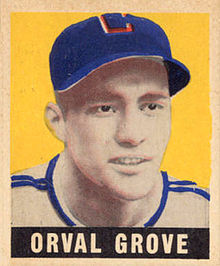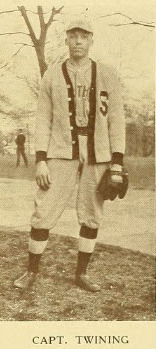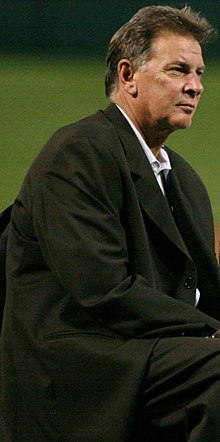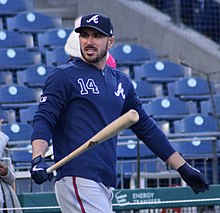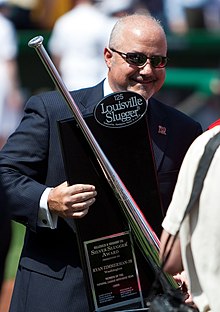Portal:Baseball
Portal maintenance status: (June 2018)
|
| Main page | Content, Categories & Topics | WikiProjects & Things you can do |
The Baseball Portal
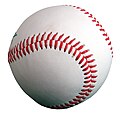
Baseball is a bat-and-ball sport played between two teams of nine players each, taking turns batting and fielding. The game occurs over the course of several plays, with each play generally beginning when a player on the fielding team, called the pitcher, throws a ball that a player on the batting team, called the batter, tries to hit with a bat. The objective of the offensive team (batting team) is to hit the ball into the field of play, away from the other team's players, allowing its players to run the bases, having them advance counter-clockwise around four bases to score what are called "runs". The objective of the defensive team (referred to as the fielding team) is to prevent batters from becoming runners, and to prevent runners' advance around the bases. A run is scored when a runner legally advances around the bases in order and touches home plate (the place where the player started as a batter).
The opposing teams switch back and forth between batting and fielding; the batting team's turn to bat is over once the fielding team records three outs. One turn batting for each team constitutes an inning. A game is usually composed of nine innings, and the team with the greater number of runs at the end of the game wins. Most games end after the ninth inning, but if scores are tied at that point, extra innings are usually played. Baseball has no game clock, though some competitions feature pace-of-play regulations such as the pitch clock to shorten game time.
Baseball evolved from older bat-and-ball games already being played in England by the mid-18th century. This game was brought by immigrants to North America, where the modern version developed. Baseball's American origins, as well as its reputation as a source of escapism during troubled points in American history such as the American Civil War and the Great Depression, have led the sport to receive the moniker of "America's Pastime"; since the late 19th century, it has been unofficially recognized as the national sport of the United States, though in modern times is considered less popular than other sports, such as American football. In addition to North America, baseball spread throughout the rest of the Americas and the Asia–Pacific in the 19th and 20th centuries, and is now considered the most popular sport in parts of Central and South America, the Caribbean, and East Asia, particularly in Japan, South Korea, and Taiwan. (Full article...)
 Featured articles - load new batch
Featured articles - load new batch
-
Image 1
Riders Field, formerly known as Dr Pepper/Seven Up Ballpark and Dr Pepper Ballpark, is a baseball park in Frisco, Texas, United States. The home of the Double-A Frisco RoughRiders of the Texas League, it opened on April 3, 2003, and can seat up to 10,216 people. Though primarily a venue for Minor League Baseball games, the facility also hosts high school and college baseball tournaments, and other public and private events throughout the year. It has been the site of three Texas League All-Star Games.
Since its opening, Riders Field has won awards and garnered praise for its unique design, feel, and numerous amenities. In his design, park architect David M. Schwarz desired the creation of a village-like "park within a (ball)park". The stadium received the 2003 Texas Construction Award for Best Architectural Design. (Full article...) -
Image 2
Daniel Lucius "Doc" Adams (November 1, 1814 – January 3, 1899) was an American baseball player and executive who is regarded by historians as an important figure in the sport's early years. For most of his career he was a member of the New York Knickerbockers. He first played for the New York Base Ball Club in 1840 and started his Knickerbockers career five years later, continuing to play for the club into his forties and to take part in inter-squad practice games and matches against opposing teams. Researchers have called Adams the creator of the shortstop position, which he used to field short throws from outfielders. In addition to his playing career, Adams manufactured baseballs and oversaw bat production; he also occasionally acted as an umpire.
From 1847 to 1861, the Knickerbockers selected Adams as their president six times, and as a vice president, treasurer, or director in six other years. As president of the club, Adams was an advocate of rule changes in baseball that resulted in nine-man teams and nine-inning games. When the National Association of Base Ball Players (NABBP) was formed in 1858, he led the rules and regulations committee of the new organization. In his role, Adams ruled that the fields' bases should be 90 feet (27 m) apart, the modern distance, and supported the elimination of the "bound rule", which allowed for balls caught after one bounce to be recorded as outs. He resigned from his positions with the Knickerbockers and NABBP in 1862. Adams' contributions in creating baseball's rules went largely unrecognized for decades after his 1899 death, but in 1980 a letter about him appeared in The New York Times; by 1993, researcher John Thorn had written about Adams' role. Other historians have given him credit for helping to develop the sport, and Thorn has called Adams "first among the Fathers of Baseball". (Full article...) -
Image 3
Michael Jeffrey Jordan (born February 17, 1963), also known by his initials MJ, is an American businessman and former professional basketball player. He played 15 seasons in the National Basketball Association (NBA) between 1984 and 2003, winning six NBA championships with the Chicago Bulls. He was integral in popularizing basketball and the NBA around the world in the 1980s and 1990s, becoming a global cultural icon. His profile on the NBA website states, "By acclamation, Michael Jordan is the greatest basketball player of all time."
Jordan played college basketball with the North Carolina Tar Heels. As a freshman, he was a member of the Tar Heels' national championship team in 1982. Jordan joined the Bulls in 1984 as the third overall draft pick and quickly emerged as a league star, entertaining crowds with his prolific scoring while gaining a reputation as one of the best defensive players. His leaping ability, demonstrated by performing slam dunks from the free-throw line in Slam Dunk Contests, earned him the nicknames "Air Jordan" and "His Airness". Jordan won his first NBA title with the Bulls in 1991 and followed that achievement with titles in 1992 and 1993, securing a three-peat. Citing physical and mental exhaustion from basketball and superstardom, Jordan abruptly retired from basketball before the 1993–94 NBA season to play Minor League Baseball in the Chicago White Sox organization. He returned to the Bulls in March 1995 and led them to three more championships in 1996, 1997, and 1998, as well as a then-record 72 regular season wins in the 1995–96 NBA season. Jordan retired for the second time in January 1999, returning for two more NBA seasons from 2001 to 2003 as a member of the Washington Wizards. He was selected to play for the United States national team during his college and NBA careers, winning four gold medals—at the 1983 Pan American Games, 1984 Summer Olympics, 1992 Tournament of the Americas and 1992 Summer Olympics—while also being undefeated. (Full article...) -
Image 4

Lawrence Winchester Wetherby (January 2, 1908 – March 27, 1994) was an American politician who served as Lieutenant Governor and Governor of Kentucky. He was the first of only two governors in state history born in Jefferson County, despite the fact that Louisville (the county seat) is the state's most populous city. The second governor born in Jefferson County is the incumbent governor, Andy Beshear.
After graduating from the University of Louisville, Wetherby held several minor offices in the Jefferson County judicial system before being elected lieutenant governor in 1947. He was called Kentucky's first "working" lieutenant governor because Governor Earle C. Clements asked him to carry out duties beyond his constitutional responsibility to preside over the state Senate, such as preparing the state budget and attending the Southern Governors Conference. In 1950, Clements resigned to assume a seat in the U.S. Senate, elevating Wetherby to governor. Wetherby won immediate acclaim by calling a special legislative session to increase funding for education and government benefits from the state's budget surplus. In 1951, he won a four-year full term as governor, during which he continued and expanded many of Clements' programs, including increased road construction and industrial diversification. He endorsed the Supreme Court's 1954 desegregation order in the case of Brown v. Board of Education and appointed a biracial commission to oversee the successful integration of the state's schools. As chairman of the Southern Governors Conference in 1954 and 1955, he encouraged other southern governors to accept and implement desegregation. (Full article...) -
Image 5
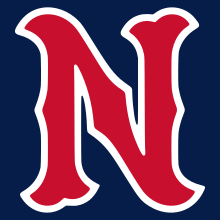
The Nashville Sounds are a Minor League Baseball team of the International League and the Triple-A affiliate of the Milwaukee Brewers. They are located in Nashville, Tennessee, and are named for the city's association with the music industry, specifically the "Nashville sound", a subgenre of country music which originated in the city in the mid-1950s. The team plays their home games at First Horizon Park, which opened in 2015 on the site of the historic Sulphur Dell ballpark. The Sounds previously played at Herschel Greer Stadium from its opening in 1978 until the end of the 2014 season. They are the oldest active professional sports franchise in Nashville.
Established as an expansion team of the Double-A Southern League in 1978, the Sounds led all of Minor League Baseball in attendance in their inaugural season and continued to draw the Southern League's largest crowds in each of their seven years as members. On the field, the team won six consecutive second-half division titles from 1979 to 1984 and won the Southern League championship twice: in 1979 as the Double-A affiliate of the Cincinnati Reds and again in 1982 as the Double-A affiliate of the New York Yankees. (Full article...) -
Image 6
Mariano Rivera (born November 29, 1969) is a Panamanian-American former professional baseball pitcher who played 19 seasons in Major League Baseball (MLB) for the New York Yankees, from 1995 to 2013. Nicknamed "Mo" and "Sandman", he spent most of his career as a relief pitcher and served as the Yankees' closer for 17 seasons. A thirteen-time All-Star and five-time World Series champion, he is MLB's career leader in saves (652) and games finished (952). Rivera won five American League (AL) Rolaids Relief Man Awards and three Delivery Man of the Year Awards, and he finished in the top three in voting for the AL Cy Young Award four times. In 2019, he was inducted into the Baseball Hall of Fame in his first year of eligibility, and is to date the only player ever to be elected unanimously by the Baseball Writers' Association of America (BBWAA).
Raised in the modest Panamanian fishing village of Puerto Caimito, Rivera was an amateur player until he was signed by the Yankees organization in 1990. He debuted in the major leagues in 1995 as a starting pitcher, before permanently converting to a relief pitcher late that year. After a breakthrough season in 1996 as a setup man, he became the Yankees' closer in 1997. In the following seasons, he established himself as one of baseball's top relievers, leading the major leagues in saves in 1999, 2001, and 2004. Rivera primarily threw a sharp-moving, mid-90s mile-per-hour cut fastball that frequently broke hitters' bats and earned a reputation as one of the league's toughest pitches to hit. With his presence at the end of games, signaled by his foreboding entrance song "Enter Sandman", Rivera was a key contributor to the Yankees' dynasty in the late 1990s and early 2000s that won four championships in five years. He was an accomplished postseason performer, winning the 1999 World Series Most Valuable Player (MVP) Award and the 2003 AL Championship Series MVP Award, while setting postseason records that included lowest earned run average (ERA) (0.70) and most saves (42). (Full article...) -
Image 7

Depiction of the game from The Boston Globe
On Saturday, May 1, 1920, the Brooklyn Dodgers and the Boston Braves played to a 1–1 tie in 26 innings, the most innings ever played in a single game in the history of Major League Baseball (MLB). The game was played at Braves Field in Boston before a crowd estimated at 4,000. Both Leon Cadore of Brooklyn and Joe Oeschger of Boston pitched complete games, and with 26 innings pitched, jointly hold the record for the longest pitching appearance in MLB history. Their record is considered unbreakable, as modern pitchers rarely pitch even nine innings, and newer baseball rules have made long extra-innings games a rarity.
The day of the game saw rainy weather, and it was uncertain if the game would be played, but the skies cleared enough to allow it to proceed. Brooklyn scored a run in the fifth inning, and Boston in the sixth; thereafter, the pitchers became increasingly dominant. As the game exceeded eighteen innings, the small crowd at Braves Field cheered both pitchers. The last twenty innings were scoreless, and when darkness started to fall, the umpires called a halt after the twenty-sixth inning, as baseball fields did not yet have artificial lighting. (Full article...) -
Image 8
William Harold Ponsford MBE (19 October 1900 – 6 April 1991) was an Australian cricketer. Usually playing as an opening batsman, he formed a successful and long-lived partnership opening the batting for Victoria and Australia with Bill Woodfull, his friend and state and national captain. Ponsford is the only player to twice break the world record for the highest individual score in first-class cricket; Ponsford and Brian Lara are the only cricketers to twice score 400 runs in an innings. Ponsford holds the Australian record for a partnership in Test cricket, set in 1934 in combination with Don Bradman (451 for 2nd wicket)—the man who broke many of Ponsford's other individual records. In fact, he along with Bradman set the record for the highest partnership ever for any wicket in Test cricket history when playing on away soil (451 runs for the second wicket)
Despite being heavily built, Ponsford was quick on his feet and renowned as one of the finest ever players of spin bowling. His bat, much heavier than the norm and nicknamed "Big Bertha", allowed him to drive powerfully and he possessed a strong cut shot. However, critics questioned his ability against fast bowling, and the hostile short-pitched English bowling in the Bodyline series of 1932–33 was a contributing factor in his early retirement from cricket a year and a half later. Ponsford also represented his state and country in baseball, and credited the sport with improving his cricketing skills. (Full article...) -
Image 9
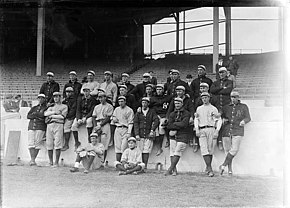
The 1913 squad, the first that went by the name "Yankees"
The history of the New York Yankees Major League Baseball (MLB) team spans more than a century. Frank J. Farrell and William Stephen Devery bought the rights to an American League (AL) club in New York City after the 1902 season. The team, which became known as the Yankees in 1913, rarely contended for the AL championship before the acquisition of outfielder Babe Ruth after the 1919 season. With Ruth in the lineup, the Yankees won their first AL title in 1921, followed by their first World Series championship in 1923. Ruth and first baseman Lou Gehrig were part of the team's Murderers' Row lineup, which led the Yankees to a then-AL record 110 wins and a Series championship in 1927 under Miller Huggins. They repeated as World Series winners in 1928, and their next title came under manager Joe McCarthy in 1932.
The Yankees won the World Series every year from 1936 to 1939 with a team that featured Gehrig and outfielder Joe DiMaggio, who recorded a record hitting streak during New York's 1941 championship season. New York set a major league record by winning five consecutive championships from 1949 to 1953, and appeared in the World Series nine times from 1955 to 1964. Mickey Mantle, Yogi Berra, and Whitey Ford were among the players fielded by the Yankees during the era. After the 1964 season, a lack of effective replacements for aging players caused the franchise to decline on the field, and the team became a money-loser for owners CBS while playing in an aging stadium. (Full article...) -
Image 10
James Howard Thome (/ˈtoʊmi/; TOH-mee; born August 27, 1970) is an American former professional baseball first baseman, third baseman and designated hitter, who played in Major League Baseball (MLB) for 22 seasons (1991–2012). A prolific power hitter, Thome hit 612 home runs during his career—the eighth-most all time. He amassed a total of 2,328 hits and 1,699 runs batted in (RBIs). His career batting average was .276. He was a member of five All-Star teams and won a Silver Slugger Award in 1996.
Thome grew up in Peoria, Illinois, as part of a large blue-collar family of athletes, who predominantly played baseball and basketball. After attending Illinois Central College, he was drafted by the Indians in the 1989 draft, and made his big league debut in 1991. Early in his career, Thome played third base, before eventually becoming a first baseman. With the Indians, he was part of a core of players that led the franchise to five consecutive playoff appearances in the 1990s, including World Series appearances in 1995 and 1997. Thome spent over a decade with Cleveland, before leaving via free agency after the 2002 season, to join the Philadelphia Phillies, with whom he spent the following three seasons. Traded to the Chicago White Sox before the 2006 season, he won the American League (AL) Comeback Player of the Year Award that year and joined the 500 home run club during his three-season tenure with the White Sox. By this point in his career, back pain limited Thome to being a designated hitter. After stints with the Los Angeles Dodgers and Minnesota Twins, he made brief returns to Cleveland and Philadelphia, before ending his career with the Baltimore Orioles. Upon retiring, Thome accepted an executive position with the White Sox. (Full article...) -
Image 11
Herschel Greer Stadium was a Minor League Baseball park in Nashville, Tennessee, on the grounds of Fort Negley, an American Civil War fortification, approximately two mi (3.2 km) south of the city's downtown district. The facility closed at the end of the 2014 baseball season and remained deserted for over four years until its demolition in 2019. Following an archaeological survey, the land is expected to be reincorporated into Fort Negley Park.
Greer was opened in 1978 for the Nashville Sounds, an expansion franchise of the Double-A Southern League who moved to the Triple-A American Association in 1985 and to the Triple-A Pacific Coast League in 1998. The stadium played host to the team until 2014. The subject of numerous upgrades and repairs to maintain its functionality, Greer became one of the oldest stadiums used by a Triple-A team and had fallen well below professional baseball's standards for a stadium at that class level by the end of its use. For over a decade, the Sounds attempted to secure agreements with the Metropolitan Government of Nashville and Davidson County for a new ballpark to replace Greer, eventually resulting in the construction of First Tennessee Park, which became the Sounds' new home in 2015. (Full article...) -
Image 12
Rogers Hornsby (April 27, 1896 – January 5, 1963), nicknamed "the Rajah", was an American baseball infielder, manager, and coach who played 23 seasons in Major League Baseball (MLB). He played for the St. Louis Cardinals (1915–1926, 1933), New York Giants (1927), Boston Braves (1928), Chicago Cubs (1929–1932), and St. Louis Browns (1933–1937). He was named the National League (NL)'s Most Valuable Player (MVP) twice, and was a member of one World Series championship team.
Born in Winters, Texas, and raised in Fort Worth, Texas, Hornsby played for several semi-professional and minor league teams. In 1915, he began his major league career with the St. Louis Cardinals and remained with the team for 12 seasons. During this period, Hornsby won his first MVP Award and the Cardinals won the 1926 World Series. After that season, he spent one season with the New York Giants and another with the Boston Braves before being traded to the Chicago Cubs. He played with the Cubs for four years and won his second MVP Award before the team released him in 1932. Hornsby re-signed with the Cardinals in 1933, but was released partway through the season, effectively ending his career as a full-time player. He was picked up by the St. Louis Browns and remained there until his final season in 1937, though he made only 67 appearances for them as a player. From 1925 to 1937, Hornsby was intermittently a player-manager. After retiring as a player, he managed the Browns in 1952 and the Cincinnati Reds from 1952 to 1953. (Full article...) -
Image 13
Jack Roosevelt Robinson (January 31, 1919 – October 24, 1972) was an American professional baseball player who became the first African-American to play in Major League Baseball (MLB) in the modern era. Robinson broke the color line when he started at first base for the Brooklyn Dodgers on April 15, 1947. The Dodgers signing Robinson heralded the end of racial segregation in professional baseball, which had relegated black players to the Negro leagues since the 1880s.
Born in Cairo, Georgia, Robinson was raised in Pasadena, California. A four-sport student athlete at Pasadena Junior College and the University of California, Los Angeles, he was better known for football than he was for baseball, becoming a star college player with the UCLA Bruins football team. Following his college career, Robinson was drafted for service during World War II but was court-martialed for refusing to sit at the back of a segregated Army bus, eventually being honorably discharged. Afterwards, he signed with the Kansas City Monarchs of the Negro leagues, where he caught the eye of Branch Rickey, general manager of the Brooklyn Dodgers, who thought he would be the perfect candidate for breaking the color line in MLB. (Full article...) -
Image 14

Ian Michael Chappell (born 26 September 1943) is a former cricketer who played for South Australia and Australia. Known as "Chappelli", he is considered as one of the greatest captains the game has seen. He captained Australia between 1971 and 1975 before taking a central role in the breakaway World Series Cricket organisation. Born into a cricketing family—his grandfather and brother also captained Australia—Chappell made a hesitant start to international cricket playing as a right-hand middle-order batsman and spin bowler. He found his niche when promoted to bat at number three. Chappell's blunt verbal manner led to a series of confrontations with opposition players and cricket administrators; the issue of sledging first arose during his tenure as captain, and he was a driving force behind the professionalisation of Australian cricket in the 1970s. He was the captain of the Australian squad which finished as runners-up at the 1975 Cricket World Cup.
John Arlott called him "a cricketer of effect rather than the graces". An animated presence at the batting crease, he constantly adjusted his equipment and clothing, and restlessly tapped his bat on the ground as the bowler ran in. Basing his game on a sound defence learned during many hours of childhood lessons, Chappell employed the drive and square cut to full effect. He had an idiosyncratic method of playing back and across to a ball of full length and driving wide of mid-on, but his trademark shot was the hook, saying "three bouncers an over should be worth 12 runs to me". A specialist slip fielder, he was the fourth player to take one hundred Test catches. (Full article...) -
Image 15
Orval Leroy Grove (August 29, 1919 – April 20, 1992) was an American professional baseball pitcher in Major League Baseball who played for ten seasons in the American League with the Chicago White Sox. In 207 career games, Grove pitched 1,176 innings and posted a win–loss record of 63–73, with 66 complete games, 11 shutouts, and a 3.78 earned run average (ERA).
The only freshman on the Proviso Township High School varsity baseball team, Grove's pitching ability attracted the attention of the White Sox. After signing with the team in 1937, Grove moved between the major leagues and minor leagues for a few seasons until 1943, when he found a solid place in the White Sox's pitching rotation. Grove had a career-year in 1943, finishing the season with career-bests in ERA, wins, and complete games; in 1944, he made his only All-Star appearance. (Full article...)
General images - load new batch
-
Image 1Jackie Robinson in 1945, with the era's Kansas City Royals, a barnstorming squad associated with the Negro American League's Kansas City Monarchs (from Baseball)
-
Image 2A pitcher handing off the ball after being taken out of the game during a mound meeting. (from Baseball)
-
Image 3The NL champion New York Giants baseball team, 1913. Fred Merkle, sixth in line, had committed a baserunning gaffe in a crucial 1908 game that became famous as Merkle's Boner. (from History of baseball)
-
Image 4The strike zone determines the result of most pitches, and varies in vertical length for each batter. (from Baseball)
-
Image 5Pick-off attempt on runner (in red) at first base (from Baseball rules)
-
Image 6The strike zone, which determines the outcome of most pitches, varies in vertical length depending on the batter's typical height while swinging. (from Baseball rules)
-
Image 7Jackie Robinson in 1945, with the era's Kansas City Royals, a barnstorming squad associated with the Negro American League's Kansas City Monarchs (from History of baseball)
-
Image 8Rickey Henderson—the major leagues' all-time leader in runs and stolen bases—stealing third base in a 1988 game (from Baseball)
-
Image 9A runner sliding into home plate and scoring. (from Baseball)
-
Image 10Diagram of a baseball field Diamond may refer to the square area defined by the four bases or to the entire playing field. The dimensions given are for professional and professional-style games. Children often play on smaller fields. (from Baseball)
-
Image 11Cy Young—the holder of many major league career marks, including wins and innings pitched, as well as losses—in 1908. MLB's annual awards for the best pitcher in each league are named for Young. (from Baseball)
-
Image 12A New York Yankees batter (Andruw Jones) and a Boston Red Sox catcher at Fenway Park (from Baseball)
-
Image 14Japanese-Americans spectating a World War II-era game while in an internment camp. America's ties to immigrants and to Japan have been deeply shaped by a shared baseball heritage. (from History of baseball)
-
Image 15Baseball games sometimes end in a walk-off home run, with the batting team usually gathering at home plate to celebrate the scoring of the winning run(s). (from Baseball rules)
-
Image 16Cover of Official Base Ball Rules, 1921 edition, used by the American League and National League (from Baseball rules)
-
Image 17Defensive positions on a baseball field, with abbreviations and scorekeeper's position numbers (not uniform numbers) (from Baseball)
-
Image 18A batter follows through after swinging at a pitched ball. (from Baseball rules)
-
Image 20In May 2010, the Philadelphia Phillies' Roy Halladay pitched the 20th major league perfect game. That October, he pitched only the second no-hitter in MLB postseason history. (from History of baseball)
-
Image 21Alexander Cartwright, father of modern baseball (from History of baseball)
-
Image 252013 World Baseball Classic championship match between the Dominican Republic and Puerto Rico, March 20, 2013 (from Baseball)
-
Image 26The standard fielding positions (from Baseball rules)
-
Image 27Pesäpallo, a Finnish variation of baseball, was invented by Lauri "Tahko" Pihkala in the 1920s, and after that, it has changed with the times and grown in popularity. Picture of Pesäpallo match in 1958 in Jyväskylä, Finland. (from Baseball)
-
Image 29Baserunners generally stand a short distance away from their base between pitches, preparing themselves to either go back or steal the next base. (from Baseball rules)
-
Image 30A first baseman receives a pickoff throw, as the runner dives back to first base. (from Baseball)
-
Image 31Sadaharu Oh managing the Japan national team in the 2006 World Baseball Classic. Playing for the Central League's Yomiuri Giants (1959–80), Oh set the professional world record for home runs with 868. (from History of baseball)
-
Image 32Two players on the baseball team of Tokyo, Japan's Waseda University in 1921 (from Baseball)
-
Image 34A game from the Cantigas de Santa Maria, c. 1280, involving tossing a ball, hitting it with a stick and competing with others to catch it (from History of baseball)
-
Image 35A well-worn baseball (from Baseball)
-
Image 36By the 1860s Civil War, baseball (bottom) had overtaken its fellow bat-and-ball sport cricket (top) in popularity within the United States. (from History of baseball)
-
Image 37An Afghan girl playing baseball in August 2002 (from Baseball)
-
Image 38The typical motion of a right-handed pitcher (from Baseball rules)
-
Image 39Fenway Park, home of the Boston Red Sox. The Green Monster is visible beyond the playing field on the left. (from Baseball)
-
Image 40The American Tobacco Company's line of baseball cards featured shortstop Honus Wagner of the Pittsburgh Pirates from 1909 to 1911. In 2007, the card shown here sold for $2.8 million. (from Baseball)
-
Image 42Pitchers are generally substituted during mound visits (team gatherings at the pitcher's mound). (from Baseball rules)
-
Image 431906 World Series, infielders playing "in" for the expected bunt and the possible play at the plate with the bases loaded (from Baseball rules)
-
Image 44Sadaharu Oh managing the Japan national team in the 2006 World Baseball Classic. Playing for the Central League's Yomiuri Giants (1959–80), Oh set the professional world record for home runs. (from Baseball)
 Good articles - load new batch
Good articles - load new batch
-
Image 1Vern Donald Freiburger (December 19, 1923 – February 27, 1990) was an American Major League Baseball first baseman who played in two games for the Cleveland Indians on September 6 and September 15 during the 1941 season. At 17 years of age, he was the youngest player to appear in an American League game that season.
Born in Michigan, Freiburger was signed by the Cleveland Indians organization while still in high school. He played one season of minor league baseball, then was given a tryout on the major league roster. After spending 1942 in the minor leagues, he enlisted with the United States Navy to serve in World War II. Upon returning from military service, he returned to the minor leagues, but was no longer considered a major prospect for the Indians, and he proceeded to play in mostly the lower level minor leagues until 1952. Freiburger then retired to California and died in 1990. (Full article...) -
Image 2
Alexander Jonathan Gordon (born February 10, 1984) is an American former professional baseball left fielder who played his entire career for the Kansas City Royals of Major League Baseball (MLB) from 2007 to 2020. Prior to playing professionally, Gordon attended the University of Nebraska–Lincoln, where he played college baseball for the Nebraska Cornhuskers.
At Nebraska, Gordon won the Brooks Wallace Award, Dick Howser Trophy, and Golden Spikes Award in 2005. That year, the Royals selected Gordon with the second overall pick in the 2005 MLB Draft. Gordon made his major league debut in 2007 as a third baseman, but had an inconsistent beginning to his career. In 2010, the Royals demoted Gordon to the minor leagues for a substantial period of time, and moved Gordon from third base to the outfield. He returned to the Royals later that season as a full-time outfielder, and his play improved substantially. A member of the Royals' 2015 World Series championship team, Gordon signed a four-year free agent contract that offseason to remain with the team. Gordon won eight Gold Glove Awards, two Platinum Glove Awards, four Fielding Bible Awards, and a Wilson Defensive Player of the Year Award, all after the move to the outfield. (Full article...) -
Image 3Moore with the Detroit Tigers in 2019
Matthew Cody Moore (born June 18, 1989) is an American professional baseball pitcher who is a free agent. He has played in Major League Baseball (MLB) for the Tampa Bay Rays, San Francisco Giants, Texas Rangers, Detroit Tigers, Philadelphia Phillies, Los Angeles Angels, Cleveland Guardians, and Miami Marlins and in Nippon Professional Baseball (NPB) for the Fukuoka SoftBank Hawks.
Born in Fort Walton Beach, Florida, Moore's family moved to Okinawa when he was seven and Edgewood, New Mexico in 2000. Although he had committed to play college baseball with the University of New Mexico, Moore chose to sign a professional contract with the Rays after they selected him in the 2007 MLB draft. He set multiple strikeout records for the Rays' farm system before making his major league debut in 2011. Moore spent two full seasons with the Rays before Tommy John surgery caused him to miss the 2014 season. He returned in 2015, and was traded to the Giants the following year. (Full article...) -
Image 4

Thomas Virgil Sturdivant (April 28, 1930 – February 28, 2009), nicknamed "Snake", was an American pitcher who played for the New York Yankees, Kansas City Athletics, Boston Red Sox, Washington Senators, Pittsburgh Pirates, Detroit Tigers, and New York Mets of Major League Baseball. He threw a curveball and a knuckleball, among other pitches. He batted left-handed but threw right-handed.
Sturdivant was originally signed by the Yankees as an infielder in 1948. After a two-year stint in the United States Army, he became a pitcher in order to improve his chances of making the major leagues. He debuted with the Yankees in 1955, the first of four straight years he was on a World Series roster. In 1956, he had a 16–8 record, led the American League (AL) with a 2.12 strikeout-to-walk ratio, and won Game 4 of the 1956 World Series, which the Yankees won in seven games over the Brooklyn Dodgers. He went 16–6 in 1957, tying for the AL lead in winning percentage with a .727 mark. Arm trouble and a spike wound to the heel limited him in 1958, though he won his second World Series as the Yankees defeated the Milwaukee Braves in seven games. (Full article...) -
Image 5The 1980 National League West tie-breaker game was a one-game extension to Major League Baseball's (MLB) 1980 regular season, played between the Houston Astros and Los Angeles Dodgers to decide the winner of the National League's (NL) West Division. The game was played on October 6, 1980, at Dodger Stadium in Los Angeles, California. It was necessary after the Dodgers overcame a three-game deficit in the final three games of the season and both teams finished with identical win–loss records of 92–70. The Dodgers won a coin flip late in the season which, by rule at the time, awarded them home field for the game.
The Astros won the game, 7–1, with Houston starter Joe Niekro throwing a complete game. This victory advanced the Astros to the 1980 NL Championship Series (NLCS), in which they lost to the Philadelphia Phillies, ending the Astros' season. In baseball statistics, the tie-breaker counted as the 163rd regular season game for both teams, with all events in the game added to regular season statistics. (Full article...) -
Image 6Donald Paul Black (July 20, 1916 or 1917 – April 21, 1959) was an American right-handed pitcher in Major League Baseball who played for six seasons in the American League with the Philadelphia Athletics and Cleveland Indians. In 154 career games, Black pitched 797 innings and posted a win–loss record of 34–55, with 37 complete games, four shutouts, and a 4.35 earned run average (ERA).
Born in Salix, Iowa, he played minor league baseball in Fairbury, Nebraska, and Petersburg, Virginia, before signing with the Philadelphia Athletics. He played with them for three seasons before being released. Black signed with the Cleveland Indians at the end of 1945, and after a season with them joined Alcoholics Anonymous. After completing the program, during the off season, he then played two more seasons with Cleveland, pitching a no-hitter on July 10, 1947. On September 13, 1948, Black suffered a cerebral hemorrhage on the field, which marked the end of his professional career. After a comeback attempt, Black went on to become a sports announcer and salesman. He died in 1959. (Full article...) -
Image 7
Travis Calvin Jackson (November 2, 1903 – July 27, 1987) was an American baseball shortstop. In Major League Baseball (MLB), Jackson played for the New York Giants from 1922 through 1936, winning the 1933 World Series, and representing the Giants in the MLB All-Star Game in 1934. After his retirement as a player, Jackson managed in minor league baseball through to the 1960 season.
Jackson was discovered by Kid Elberfeld at a minor league baseball game at the age of 14. Elberfeld signed Jackson to his first professional contract, and recommended him to John McGraw, manager of the Giants. His exceptional range at shortstop led to the nickname "Stonewall." Jackson was inducted into the National Baseball Hall of Fame in 1982. (Full article...) -
Image 8
Howard Earle "Twink" Twining (May 30, 1894 – June 14, 1973) was an American professional baseball pitcher who played one game in Major League Baseball (MLB) for the Cincinnati Reds. He played baseball and basketball at Swarthmore College and later became a prominent dermatologist. (Full article...) -
Image 9The Calgary Cannons were a minor league baseball team located in Calgary, Alberta, for 18 seasons, from 1985 until 2002. They were a member of the AAA Pacific Coast League (PCL) and played at Foothills Stadium. The Cannons displaced the Calgary Expos, who played in the rookie level Pioneer League from 1977 until 1984. The team was previously known as the Salt Lake City Gulls before being relocated to Calgary. Following the 2002 season, the team moved to Albuquerque, New Mexico, where they became the Isotopes.
The Cannons played 2,538 regular season games in Calgary, compiling a record of 1,225–1,308. They qualified for the playoffs five times: 1985, 1987, 1989, and 1991 as an affiliate of the Seattle Mariners, and 1998 as an affiliate of the Chicago White Sox. They reached the PCL Championship Series three times, in 1987, 1991, and 1998, though they never won a title. (Full article...) -
Image 10Zoldak's 1949 Bowman Gum baseball card
Samuel Walter Zoldak, nicknamed Sad Sam, (December 8, 1918 – August 25, 1966) was an American professional baseball pitcher. He played in Major League Baseball (MLB) for nine seasons in the American League with the St. Louis Browns, Cleveland Indians, and Philadelphia Athletics. In 250 career games, Zoldak pitched 929+1⁄3 innings and posted a win–loss record of 43–53, with 30 complete games, five shutouts, and a 3.54 earned run average (ERA).
Although an average hitting pitcher in his major league career, posting a .175 batting average (50-for-286) with just 16 runs and 11 RBIs, he was a very good fielding pitcher, posting a .984 fielding percentage with only four errors in 258 total chances. (Full article...) -
Image 11
LaTroy Hawkins (born December 21, 1972) is an American former professional baseball pitcher. In his 21-year Major League Baseball (MLB) career, he played for the Minnesota Twins, Chicago Cubs, San Francisco Giants, Baltimore Orioles, Colorado Rockies, New York Yankees, Houston Astros, Milwaukee Brewers, Los Angeles Angels of Anaheim, New York Mets, and Toronto Blue Jays. Through the 2020 season, his 1,042 games pitched were the 10th-most of any major league player. He has also registered saves against all 30 MLB teams.
Born and raised in Gary, Indiana, Hawkins was a seventh-round draft pick of the Twins out of high school. He debuted with the team in 1995 and reached the major leagues for good in 1997. After posting some of the worst earned run averages (ERA) in the American League (AL) in 1998 and 1999, Hawkins was moved to the bullpen in 2000. He struggled as the Twins' closer in 2001 but found better success thereafter in a setup role, posting a career-low 1.86 ERA in 2003 and reaching the playoffs in 2002 and 2003 with Minnesota. (Full article...) -
Image 12
Michael Kendall Flanagan (December 16, 1951 – August 24, 2011) was an American professional baseball left-handed pitcher, front office executive, and color commentator. He spent 18 years as a player in Major League Baseball (MLB) with the Baltimore Orioles (1975–1987, 1991–1992) and the Toronto Blue Jays (1987–1990).
Flanagan was a starting pitcher for the Orioles from 1975 through 1987. He was named to the American League (AL) All-Star Team once in 1978. In 1979, the first of two years he would play on an AL pennant winner, his 23 victories led the circuit and earned him the AL's Cy Young Award. He was a member of the Orioles' World Series Championship team in 1983. During the 1987 season, he was traded to the Toronto Blue Jays, with whom he pitched through 1990. He returned to Baltimore to close out his playing career as a relief pitcher in 1991 and 1992. During this second tour, he combined with three other pitchers to throw a no-hitter against the Oakland Athletics on July 13, 1991. He was also the last Orioles pitcher to appear in a major-league contest at Memorial Stadium. In an 18-season career, Flanagan posted a 167–143 record with 1,491 strikeouts and a 3.90 earned run average in 2,770 innings pitched. (Full article...) -
Image 13
Matthew Ryan Joyce (born August 3, 1984) is an American former professional baseball outfielder, who played 14 seasons in Major League Baseball (MLB). Between 2008 and 2021, he played for eight MLB teams, most notably the Tampa Bay Rays, with whom he was named an MLB All-Star in 2011.
Raised by a single father in Tampa, Florida, Joyce frequently attended Rays games at Tropicana Field as a child. The Detroit Tigers attended an exhibition game that Joyce played with Florida Southern College and selected him in the 12th round of the 2005 MLB Draft. Joyce debuted with the Tigers in 2008 and was traded to the Rays the following season. After five years in St. Petersburg, Florida, Joyce was traded to the Los Angeles Angels, where his performance suffered after a 2015 concussion. (Full article...) -
Image 14

Willard Elmer White (December 7, 1849 – March 17, 1872) was an American professional baseball player. He served primarily as an outfielder but also as a catcher in 1871 with the Cleveland Forest Citys of the National Association. Although he broke his arm running into a fence during a game on June 22, he played 15 of Cleveland's 29 games in their inaugural season, batting .257. However, he died of tuberculosis in March 1872, becoming the first player from a professional baseball league to die. White was the cousin of Deacon White and Will White. (Full article...) -
Image 15Shawn Patrick Sedlacek [sed′–la–check] (born June 29, 1977) is an American former professional baseball pitcher. He played part of one season in Major League Baseball (MLB), primarily as a starting pitcher, for the Kansas City Royals in 2002. Sedlacek threw a four-seam fastball, a two-seam fastball, a changeup, a slider, and a curveball.
Born in Cedar Rapids, Iowa, Sedlacek attended Iowa State University, leading the team with 65 strikeouts and 77 innings pitched as a senior before getting selected by the Royals in the 1998 MLB draft. Initially expected to be a relief pitcher, he became a starting pitcher during his first season due to injuries to other starters, and he would finish among the leaders in the minor leagues he pitched in over the next few years. The Royals called him up in June 2002 following injuries to Jeremy Affeldt and Paul Byrd, and he debuted for them on June 18. Sedlacek posted a 3.05 earned run average (ERA) in his first six starts but had a 10.10 ERA in his next eight and was moved to the bullpen in September. After pitching for Kansas City's minor league affiliates in 2003, he left the Royals organization and played for two years in the minors for several other teams and also in the independent Northern League. Remaining in the Kansas City area following his retirement, he is part of Complete Game Baseball, an organization that provides baseball training and fields its own teams. (Full article...)
Did you know (auto-generated) - load new batch

- ... that Cody Bellinger made a motion capture appearance in Assassin's Creed Valhalla as the Viking Otta Sluggasson, with Bellinger's own baseball bat serving as Sluggasson's weapon?
- ... that a painting by Major League Baseball player Gene Locklear was hung in the White House?
- ... that the 2024 inductees to the Delaware Sports Museum and Hall of Fame include a man with Down syndrome who has lifted 425 pounds (193 kg), an "average gymnast" turned Olympics judge, a "preeminent sportswriter", the state's "greatest high hurdler", the "inventor" of the modern sports mascot, a record-setting 10-year-old, a champion gymnast, an Olympic field hockey player, and a pro baseball player in five countries?
- ... that Billy Raimondi declined opportunities to play in Major League Baseball?
- ... that Cy Block and Ross Horning testified before the United States Congress about how the reserve clause limited their careers in professional baseball?
- ... that Bill Duplissea has been said to have the "best eyes in baseball"?
- ... that Richard Worley played in minor baseball leagues and is now the commissioner of the Baltimore Police Department?
- ... that baseball player Mark Littell developed an anatomically correct athletic cup called the "Nutty Buddy"?
Quotes
| Hating the [New York] Yankees is as American as pizza pie, unwed mothers, and cheating on your income tax. |
 Featured lists - load new batch
Featured lists - load new batch
-
Image 1
The Rogers Centre, home field of the Blue Jays since June 1989
This is a list of seasons completed by the Toronto Blue Jays, based in Toronto, Ontario, and a member of Major League Baseball's (MLB) American League East Division. Since June 5, 1989, the Blue Jays have played in the Rogers Centre (called the "SkyDome" until February 2, 2005). Before that, they played at Exhibition Stadium. They played their 2020 season at Sahlen Field in Buffalo, New York due to the COVID-19 pandemic. The name "Blue Jays" was chosen via a contest in 1976 from among more than 4,000 suggestions.
The Blue Jays made their MLB debut during the 1977 baseball season, as an expansion team. They first made the playoffs in 1985, by capturing the American League East Division, but lost the American League Championship Series (ALCS) in seven games to the Kansas City Royals. The team returned to the playoffs in 1989, where they lost to the Oakland Athletics in the ALCS in five games, and again in 1991, where once more the Blue Jays were defeated in the ALCS in five games, this time by the Minnesota Twins. (Full article...) -
Image 2
The Silver Slugger Award has been awarded annually since 1980 to the best offensive player at each position in both the American League and the National League, as determined by the coaches and managers of Major League Baseball.
These voters consider several offensive statistics, including batting average, slugging percentage, and on-base percentage, as well as their "general impressions of a player's overall offensive value". They are not permitted to vote for players on their team. (Full article...) -
Image 3In baseball, earned run average (ERA) is a statistic used to evaluate pitchers, calculated as the mean of earned runs given up by a pitcher per nine innings pitched.[a] A pitcher is men by a baserunner who reached base while batting against that pitcher, whether by hit, base on balls or "walk", or being hit by a pitched ball; an earned run can be charged after the pitcher is relieved if he allows the runner before leaving the game. Runs scored by players who reach base on errors, passed balls, or catcher interference under special circumstances are treated as unearned runs, and do not count towards the pitcher's ERA.
Major League Baseball recognizes the player in each league[b] with the lowest earned run average each season.[c] The first ERA champion in the National League was George Bradley; in the National League's inaugural 1876 season, Bradley posted a 1.23 ERA for the St. Louis Brown Stockings, allowing 78 earned runs in 573 innings pitched. The American League was established in 1901, and Hall of Fame pitcher Cy Young led that league with a 1.62 ERA for the Boston Americans during the 1901 season. (Full article...) -
Image 4
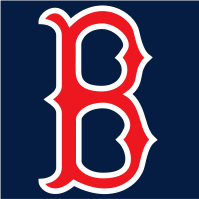
The Boston Red Sox are a Major League Baseball (MLB) team based in Boston, Massachusetts. From 1912 to the present, the Red Sox have played in Fenway Park. The "Red Sox" name originates from the iconic uniform feature. They are sometimes nicknamed the "BoSox", a combination of "Boston" and "Sox" (as opposed to the "ChiSox"), the "Crimson Hose", and "the Olde Towne Team". Most fans simply refer to them as the Sox.
One of the American League's eight charter franchises, the club was founded in Boston in 1901. They were a dominant team in the early 20th century, defeating the Pittsburgh Pirates in the first World Series in 1903. They won four more championships by 1918, and then went into one of the longest championship droughts in baseball history. Many attributed the phenomenon to the "Curse of the Bambino" said to have been caused by the trade of Babe Ruth to the New York Yankees in 1920. The drought was ended and the "curse" reversed in 2004, when the team won their sixth World Series championship. Championships in 2007 and 2013 followed. Every home game from May 15, 2003, through April 10, 2013, was sold out—a span of 820 games over nearly ten years. The team most recently won the World Series in 2018, the ninth championship in franchise history. (Full article...) -
Image 5

Iván Rodríguez has won 13 Gold Gloves, the most among catchers.
The Rawlings Gold Glove Award, usually referred to as the Gold Glove, is the award given annually to the Major League Baseball players judged to have exhibited superior individual fielding performances at each fielding position in both the National League (NL) and the American League (AL), as voted by the managers and coaches in each league. Managers are not permitted to vote for their own players. Eighteen Gold Gloves are awarded each year (with the exception of 1957, 1985, 2007 and 2018), one at each of the nine positions in each league. In 1957, the baseball glove manufacturer Rawlings created the Gold Glove Award to commemorate the best fielding performance at each position. The award was created from a glove made from gold lamé-tanned leather and affixed to a walnut base. Initially, only one Gold Glove per position was awarded to the top fielder at each position in the entire league; however, separate awards were given for the National and American Leagues beginning in 1958.
Iván Rodríguez has won the most Gold Gloves at catcher, with 13; all were won with the Texas Rangers or the Detroit Tigers (both American League teams), though Rodríguez has played in both leagues. Johnny Bench, who spent his entire career with the Cincinnati Reds, leads National Leaguers in wins, and is second overall with 10 Gold Gloves. Yadier Molina is third overall and second in the NL all time with nine. Bob Boone, who is a member of one of four family pairs to win Gold Glove Awards, won seven between both leagues during his career. Jim Sundberg has won six Gold Gloves, with Bill Freehan and Salvador Pérez winning five. There have been four 4-time winners at catcher: Del Crandall, Mike Matheny, Charles Johnson, and Tony Peña. Hall of Famers who have won as catchers include Bench, Rodriguez, Carlton Fisk, and Gary Carter.[d] The other family pair to win Gold Gloves as catchers are brothers Bengie and Yadier Molina, who have won eleven awards between them as of the end of the 2018 season[update]. (Full article...) -
Image 6
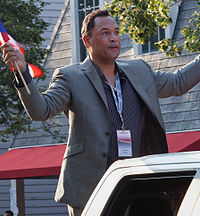
Roberto Alomar leads all second basemen with 10 Gold Glove Award wins.
The Gold Glove Award is the award given annually to the Major League Baseball players judged to have exhibited superior individual fielding performances at each fielding position in both the National League (NL) and the American League (AL), as voted by the managers and coaches in each league. Managers are not permitted to vote for their own players. Eighteen Gold Gloves are awarded each year (with the exception of 1957, 1985, 2007 and 2018), one at each of the nine positions in each league. In 1957, the baseball glove manufacturer Rawlings created the Gold Glove Award to commemorate the best fielding performance at each position. The award was created from a glove made from gold lamé-tanned leather and affixed to a walnut base. Initially, only one Gold Glove per position was awarded to the top fielder at each position in the entire league; however, separate awards were given for the National and American Leagues beginning in 1958.
Roberto Alomar leads second basemen in wins; he won 10 Gold Gloves in 11 years with three different American League teams. Ryne Sandberg has the second-highest total overall; his nine awards, all won with the Chicago Cubs, are the most by a National League player. Bill Mazeroski and Frank White are tied for the third-highest total, with eight wins. Mazeroski's were won with the Pittsburgh Pirates, and White won his with the Kansas City Royals. Joe Morgan and Bobby Richardson each won five Gold Glove Awards, and four-time winners include Craig Biggio (who won after converting to second base from catcher), Bret Boone, Bobby Grich, Orlando Hudson, Dustin Pedroia, and Brandon Phillips. Hall of Famers who won Gold Gloves at second base include Alomar, Sandberg, Mazeroski, Morgan, Biggio and Nellie Fox. (Full article...) -
Image 7

1998 Rookie of the Year Award winner Kerry Wood is one of two Cubs first-round draft picks so honored.
The Chicago Cubs are a Major League Baseball (MLB) franchise based in Chicago, Illinois. They play in the National League Central division. Since the institution of MLB's Rule 4 Draft, the Cubs have selected 68 players in the first round. Officially known as the "First-Year Player Draft", the Rule 4 Draft is MLB's primary mechanism for assigning amateur baseball players from high schools, colleges, and other amateur baseball clubs to its teams. The draft order is determined based on the previous season's standings, with the team possessing the worst record receiving the first pick. In addition, teams which lost free agents in the previous off-season may be awarded compensatory or supplementary picks.
Of the 68 players picked in the first round by the Cubs, 32 have been pitchers, the most of any position; 24 of these were right-handed, while 6 were left-handed. Sixteen players picked in the initial round were outfielders, while ten shortstops, two catchers, and one player each at first base, second base, and third base were also taken. The Cubs drafted 26 players out of high school, and 32 out of college. Chicago has drafted eleven players from high schools or colleges in the state of California, with six more coming from Texas and five from Indiana. The Cubs have also taken four players from their home state of Illinois. (Full article...) -
Image 8

Bobby Lowe was the first MLB player to hit four home runs in a single game, doing so in 1894.
In baseball, a home run occurs when the ball is hit in such a way that the batter is able to circle the bases and reach home safely in one play without any errors being committed by the defensive team in the process. In modern baseball, the feat is typically achieved by hitting the ball over the outfield fence between the foul poles (or making contact with either foul pole) without first touching the ground, resulting in an automatic home run. There is also the "inside-the-park" home run where the batter reaches home safely while the baseball is in play on the field.
Eighteen players have hit four home runs in a single Major League Baseball (MLB) game, which writers of Sporting News described as "baseball's greatest single-game accomplishment". The most recent to accomplish the feat to date is J. D. Martinez with the Arizona Diamondbacks against the Los Angeles Dodgers on September 4, 2017. No player has done this more than once in his career. In the pre-professional era, Lipman Pike also hit five home runs in 1866. No player has ever hit four home runs in a postseason game; that record is three, first accomplished by Babe Ruth in Game 4 of the 1926 World Series. (Full article...) -
Image 9

Frank Bancroft managed the Worcester team in 1879 and 1880.
The Worcester Worcesters, sometimes referred to as the Brown Stockings or the Ruby Legs, were a Major League Baseball team based in Worcester, Massachusetts. Though the team's alternate names appear in many modern sources, no contemporary records from the time exist that support the use of names other than "Worcester". They existed in the National League (NL) from 1880 to 1882, and played their home games at the Worcester Agricultural Fairgrounds.
The team was organized in 1879 as the Worcester Baseball Association, and joined the minor league National Association. The team was profitable, successful against rival teams, and did well against NL teams in exhibition games. After the season, team management turned their attention on the NL, and pursued the slot vacated by the departing Syracuse Stars. The team was voted into the NL by a majority of the owners, and in 1880, the team began their first season. The manager of the team, Frank Bancroft, and many of the players stayed with the team when it joined the NL, including pitchers Lee Richmond and Tricky Nichols, and position players Arthur Irwin, Doc Bushong, Charlie Bennett, and Chub Sullivan. On June 12, Richmond threw the first perfect game in major league history, against the Cleveland Blues. Harry Stovey, in his first major league season, led the league in triples and home runs. However, the Ruby Legs were, in turn, no-hit on August 20 by Pud Galvin of the Buffalo Bisons, becoming the first team to be no-hit at home. They played 85 games in their first season, and had a win–loss record of 40 wins, 43 losses, with 2 ties, finishing fifth in the league. (Full article...) -
Image 10The Tampa Bay Rays are a Major League Baseball (MLB) franchise based in St. Petersburg, Florida. They play in the American League East division. The first game of the new baseball season for a team is played on Opening Day, and being named the Opening Day starter is an honor, which is often given to the player who is expected to lead the pitching staff that season, though there are various strategic reasons why a team's best pitcher might not start on Opening Day. The Rays have used fifteen different Opening Day starting pitchers in their twenty-six seasons. Since the franchise's beginning in 1998, the fifteen starters have a combined Opening Day record of seven wins, ten losses (7–10), and nine no decisions. "No decisions" are awarded to the starting pitcher if the game is won or lost after the starting pitcher has left the game.
Chris Archer and James Shields holds the Rays' record for most Opening Day starts with four. Archer has one win, two losses, and one no decision, while Shields has one win, one loss, and two no decisions. The all-time record for a Tampa Bay starting pitcher winning an Opening Day game is one, shared by Steve Trachsel, Albie Lopez, Victor Zambrano, James Shields, David Price, Chris Archer, and Shane McClanahan. (Full article...) -
Image 11

The 1879 Cleveland Blues baseball team
The Cleveland Blues were a professional baseball franchise that operated in the National League (NL), a "major" league, from 1879 until 1884. They were organized by businessmen William Hollinger, and J. Ford Evans in 1878 as the Forest Citys, and played a season as an independent team. The NL expanded from six teams to eight before the 1879 season, and the Forest Citys accepted an invitation to join the league. Evans became their president and stayed in that capacity until C. H. Bulkeley assumed the role in 1882. In their six seasons in the NL, the team never finished higher than third place in the standings. They played their home games in League Park.
For their first season in the NL, the franchise (now named the Blues due to their dark blue uniforms) employed Jim McCormick as the manager as well as the ace of their pitching staff. Cleveland did not fare well, winning just 27 games against 55 losses, with a league-low .223 batting average. The 1880 season was better, however, as the team increased its win total to 47 against 37 losses and a tie, McCormick winning a league-leading 45 of those victories. Over the next two seasons, the team changed the on-field leadership often; employing Mike McGeary and John Clapp as player-managers in 1881, and Fred Dunlap in 1882. The changes did not prove effective as the team was unable to finish higher than fifth place during that span. The team had their best record and highest win total in 1883 under manager Frank Bancroft. On September 13, 1883, Hugh Daily threw the franchise's lone no-hitter. (Full article...) -
Image 12Jackie Robinson, the inaugural winner in 1947 and eventual namesake of the award
In Major League Baseball, the Rookie of the Year Award is given annually to two outstanding rookie players, one each for the American League (AL) and National League (NL), as voted on by the Baseball Writers' Association of America (BBWAA). The award was established in 1940 by the Chicago chapter of the BBWAA, which selected an annual winner from 1940 through 1946. The award became national in 1947; Jackie Robinson, the Brooklyn Dodgers' second baseman, won the inaugural award. One award was presented for all of MLB in 1947 and 1948; since 1949, the honor has been given to one player each in the NL and AL. Originally, the award was known as the J. Louis Comiskey Memorial Award, named after the Chicago White Sox owner of the 1930s. The award was renamed the Jackie Robinson Award in July 1987, 40 years after Robinson broke the baseball color line.
Nineteen players have been elected to the National Baseball Hall of Fame—Robinson, seven AL players, and eleven others from the NL. The award has been shared twice: once by Butch Metzger and Pat Zachry of the NL in 1976; and once by John Castino and Alfredo Griffin of the AL in 1979. Members of the Brooklyn and Los Angeles Dodgers have won the most awards of any franchise (with 18). Fred Lynn and Ichiro Suzuki are the only two players who have been named Rookie of the Year and Most Valuable Player in the same year, and Fernando Valenzuela is the only player to have won Rookie of the Year and the Cy Young Award in the same year. Sam Jethroe is the oldest player to have won the award, at age 32, 33 days older than 2000 winner Kazuhiro Sasaki (also 32). Luis Gil of the New York Yankees and Paul Skenes of the Pittsburgh Pirates are the most recent winners. (Full article...) -
Image 13

Mike Mussina (1990) made five all-star appearances with the Orioles.
The Baltimore Orioles are a Major League Baseball (MLB) franchise based in Baltimore, Maryland. They play in the American League East division. Since the institution of MLB's Rule 4 Draft, the Orioles have selected 60 players in the first round. Officially known as the "First-Year Player Draft", the Rule 4 Draft is MLB's primary mechanism for assigning amateur baseball players from high schools, colleges, and other amateur baseball clubs to its teams. The draft order is determined based on the previous season's standings, with the team possessing the worst record receiving the first pick. In addition, teams which lost free agents in the previous off-season may be awarded compensatory or supplementary picks.
Of the 60 players picked in the first round by Baltimore, 30 have been pitchers, the most of any position; 21 of them were right-handed, while 9 were left-handed. Twelve outfielders, eight shortstops, seven catchers, two third basemen, and one second basemen were also taken. The team has never drafted a player at first base. 16 of the players came from high schools or universities in the state of California, and Florida follows with five players. The Orioles have also drafted two players from Canada, Ntema Ndungidi (1997) and Adam Loewen (2002). The Orioles have not drafted any players from their home state of Maryland. (Full article...) -
Image 14

Reggie Jackson (1966) won three World Series titles with the A's and was elected to the Baseball Hall of Fame in 1993.
The Oakland Athletics (the A's) are a Major League Baseball (MLB) franchise based in Oakland, California. They play in the American League West division. The Athletics had played in Philadelphia from 1901 to 1954 and then Kansas City from 1955 to 1967 before moving to Oakland. Since the establishment of the Rule 4 Draft the Athletics have selected 82 players in the first round. Officially known as the "First-Year Player Draft", the Rule 4 Draft is MLB's primary mechanism for assigning players from high schools, colleges, and other amateur clubs to its franchises. The draft order is determined based on the previous season's standings, with the team possessing the worst record receiving the first pick. In addition, teams which lost free agents in the previous off-season may be awarded compensatory or supplementary picks.
Of these 82 players, 36 have been pitchers, the most of any position; 27 of these were right-handed, while 9 were left-handed. Fifteen outfielders, including one center fielder, and 14 shortstops were selected. The A's have also drafted seven catchers, five third basemen, four first basemen, and one second baseman in the first round. Additionally, 23 players came from high schools or universities in the A's home state of California, followed by 10 from Texas and Florida. They also drafted Ariel Prieto in 1995, who had defected from Cuba the year before. Prieto made his major league debut in 1995, one of 20 players in draft history to go directly to the majors without playing in the minor leagues. (Full article...) -
Image 15

Bob Feller made seven Opening Day starts for the Cleveland Indians.
The Cleveland Guardians are a Major League Baseball (MLB) franchise based in Cleveland, Ohio; until 2021, they were known as the Cleveland Indians. They play in the American League Central division. The first game of the new baseball season is played on Opening Day, and being named the starter that day is an honor, which is often given to the player who is expected to lead the pitching staff that season, though there are various strategic reasons why a team's best pitcher might not start on Opening Day. Since joining the league in 1901, the Indians have used 58 different Opening Day starting pitchers which includes the Opening Day starting pitchers from the Bluebirds and the Naps. They have a record of 58 wins and 54 losses in their Opening Day games.
The Indians have played in three different home ball parks, League Park from 1901 through 1946, Cleveland Stadium from 1932 to 1993, and Progressive Field since 1994. From 1934 through 1946 some games were played at League Park and some at Cleveland Stadium. They had a record of 11 wins and 4 losses in Opening Day games at League Park, 9 wins and 13 losses at Cleveland Stadium and 2 wins and 4 losses at Progressive Field, for a total home record in Opening Day games of 22 wins and 21 losses. Their record in Opening Day away games is 35 wins and 35 losses. (Full article...)
More did you know
- ... that baseball Hall of Famer Rogers Hornsby had his first plate appearance against King Lear?
- ... that the Philadelphia Phillies were the last of the original 16 Major League Baseball franchises to win the World Series?
- ... that Harry Blackmun's colleagues on the U.S. Supreme Court felt his long history of baseball in the Flood v. Kuhn majority opinion was beneath the Court's dignity?
- ... that the Danville 97s minor league baseball team name of 97s was selected as a tribute to the victims of the Wreck of the Old 97 train accident?
- ... that Frank Graham called Dave Bancroft "the greatest shortstop the Giants ever had and one of the greatest that ever lived"?
Sports portals
Selected picture

| Credit: Harris & Ewing |
The 1937 Major League Baseball All-Star Game was the fifth playing of the mid-summer classic between the all-stars of the American League (AL) and National League (NL), the two leagues comprising Major League Baseball. The game was held on July 7, 1937 at Griffith Stadium in Washington D.C., the home of the Washington Senators of the American League. The game resulted in the American League defeating the National League 8-3. The game, watched by President Franklin D. Roosevelt, is remembered because of a play in which Earl Averill of the Indians hit a ball that struck pitcher Dizzy Dean on the toe, breaking it.
Associated Wikimedia
The following Wikimedia Foundation sister projects provide more on this subject:
-
Commons
Free media repository -
Wikibooks
Free textbooks and manuals -
Wikidata
Free knowledge base -
Wikinews
Free-content news -
Wikiquote
Collection of quotations -
Wikisource
Free-content library -
Wikiversity
Free learning tools -
Wiktionary
Dictionary and thesaurus
More portals
- Portals with triaged subpages from June 2018
- All portals with triaged subpages
- Portals with no named maintainer
- Automated article-slideshow portals with 51–100 articles in article list
- Automated article-slideshow portals with 501–1000 articles in article list
- Random portal component with 41–50 available subpages
- Automated article-slideshow portals with 201–500 articles in article list
- Random portal component with 11–15 available subpages
- Random portal component with 21–25 available image subpages










